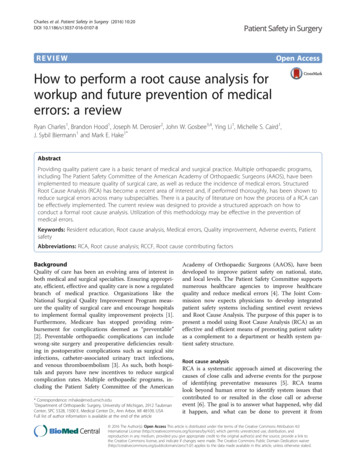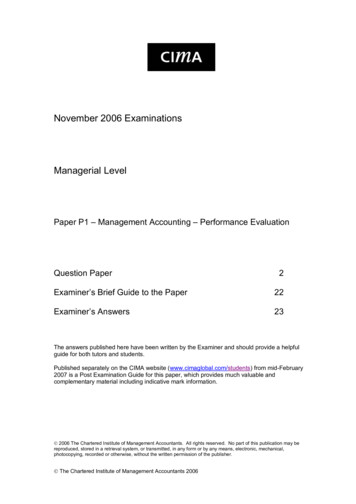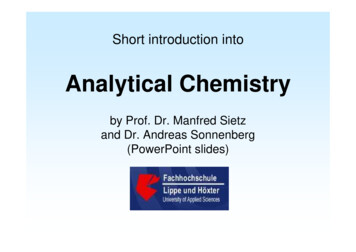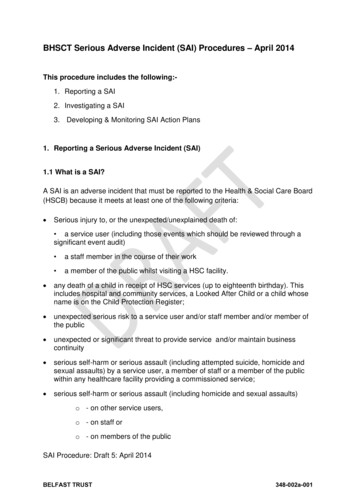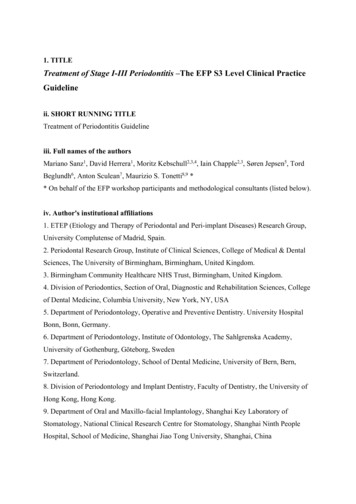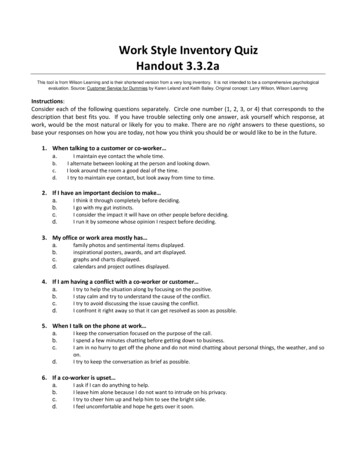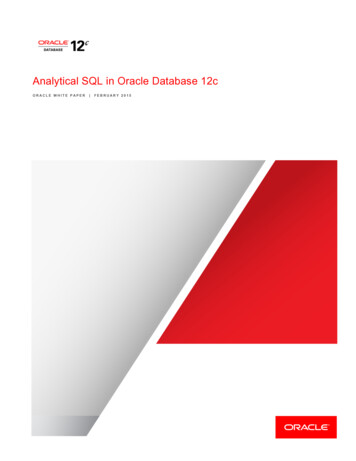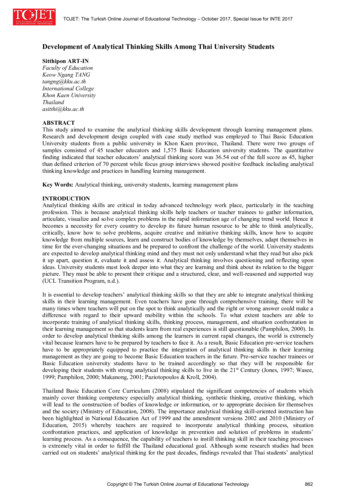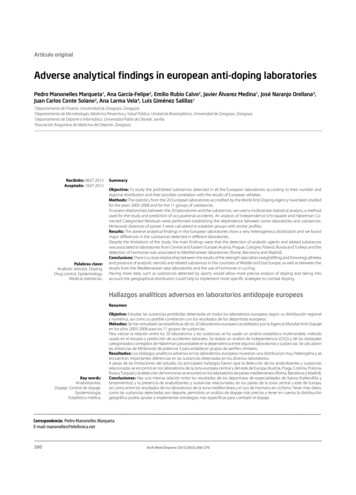
Transcription
Artículo originalAdverse analytical findings in european anti-doping laboratoriesPedro Manonelles Marqueta1, Ana García-Felipe2, Emilio Rubio Calvo2, Javier Álvarez Medina1, José Naranjo Orellana3,Juan Carlos Conte Solano2, Ana Larma Vela4, Luis Giménez Salillas11Departamento de Fisiatría. Universidad de Zaragoza. Zaragoza.Departamento de Microbiología, Medicina Preventiva y Salud Pública. Unidad de Bioestadística. Universidad de Zaragoza. Zaragoza.3Departamento de Deporte e Informática. Universidad Pablo de Olavide. Sevilla.4Asociación Aragonesa de Medicina del Deporte. Zaragoza.2Recibido: 08.07.2013Aceptado: 18.07.2013Palabras clave:Anabolic steroids. Doping.Drug control. Epidemiology.Medical statistician.SummaryObjective: To study the prohibited substances detected in all the European laboratories according to their number andregional distribution and their possible correlation with the results of European athletes.Methods: The statistics from the 20 European laboratories accredited by the World Anti-Doping Agency have been studiedfor the years 2003-2008 and for the 11 groups of substances.To assess relationships between the 20 laboratories and the substances, we used a multivariate statistical analysis, a methodused for the study and prediction of occupational accidents. An analysis of independence (chi-square) and Haberman Corrected Categorized Residuals were performed establishing the dependence between some laboratories and substances.Minkowski distances of power 3 were calculated to establish groups with similar profiles.Results: The adverse analytical findings in the European laboratories show a very heterogeneus distribution and we foundmajor differences in the substances detected in different laboratories.Despite the limitations of the study, the main findings were that the detection of anabolic agents and related substanceswas associated to laboratories from Central and Eastern Europe (Austria, Prague, Cologne, Poland, Russia and Turkey) and thedetection of hormones was associated to Mediterranean laboratories (Rome, Barcelona and Madrid).Conclusions: There is a close relationship between the results of the strength specialties (weightlifting and throwing) athletesand presence of anabolic steroids and related substances in the countries of Middle and East Europe, as well as between theresults from the Mediterranean area laboratories and the use of hormones in cycling.Having more data, such as substances detected by sports, would allow more precise analysis of doping and taking intoaccount the geographical distribution could help to implement more specific strategies to combat doping.Hallazgos analíticos adversos en laboratorios antidopaje europeosResumenKey words:Anabolizantes.Dopaje. Control de dopaje.Epidemiología.Estadística médica.Objetivo: Estudiar las sustancias prohibidas detectadas en todos los laboratorios europeos según su distribución regionaly numérica, así como su posible correlacion con los resultados de los deportistas europeos.Métodos: Se han estudiado las estadísticas de los 20 laboratorios europeos acreditados por la Agencia Mundial Anti-Dopajeen los años 2003-2008 para los 11 grupos de sustancias.Para valorar la relación entre los 20 laboratorios y las sustancias se ha usado un análisis estadístico multivariable, métodousado en el estudio y predicción de accidentes laborales. Se realizó un analisis de independencia (Chi2) y de los residualescategorizados corregidos de Haberman para establecer la dependencia entre algunos laboratorios y sustancias. Se calcularonlas distancias de Minkowski de potencia 3 para establecer grupos de perfiles similares.Resultados: Los hallazgos analíticos adversos en los laboratorios europeos muestran una distribucion muy heterogéna y seencuentran importantes diferencias en las sustancias detectadas en los diversos laboratorios.A pesar de las limitaciones del estudio, los principales hallazgos fueron que la detección de los anabolizantes y sustanciasrelacionadas se encontró en los laboratorios de la zona europea central y del este de Europa (Austria, Praga, Colonia, Polonia,Rusia y Turquía) y la detección de hormonas se encontró en los laboratorios de paises mediterráneos (Roma, Barcelona y Madrid).Conclusiones: Hay una intensa relación entre los resultados de los deportistas de especialidades de fuerza (halterofilia ylanzamientos) y la presencia de anabolizantes y sustancias relacionadas, en los paises de la zona central y este de Europa,así como entre los resultados de los laboratorios de la zona mediterránea y el uso de hormans en ciclismo. Tener más datos,como las sustancias detectadas por deporte, permitiría un análisis de dopaje más preciso y tener en cuenta la distribucióngeográfica podría ayudar a implementer estrategias más específicas para combatir el dopaje.Correspondencia: Pedro Manonelles MarquetaE-mail: manonelles@telefonica.net260Arch Med Deporte 2013;30(5):260-270
Adverse analytical findings in european anti-doping laboratoriesIntroductionsubstances detected in a laboratory could be indicators of the kind ofsports practiced in a region and they could indicate the number ofathletes involved.Europe has half of the accredited laboratories and a high numberof doping controls are performed, but there are few studies relatingthe AAF with certain sports or the regions where they are practiced3-12.The aim of this work was to study the prohibited substancesdetected in all the European laboratories (number and regional distribution) and their possible correlation with the results of Europeanathletes. These data could help to implement more specific strategiesto combat doping.Doping is a big concern for the Sports authorities and governmentsaround the World and, as a result, the World Anti-Doping Agency (WADA)was created to lead the fight against doping through the guidelines ofthe World Anti-Doping Code1. One of the actions is to carry out dopingcontrols through an international network of accredited laboratorieswith excellent reliability and accuracy of results.In addition to other actions, such as research, education and closeinternational cooperation2, the fight against doping requires a clear understanding of aspects such as the different ways to use the prohibitedsubstances and methods or how to circumvent controls. The so called“risk zones” include not only the athletes themselves and the characteristics of sports, but also the geographical areas. The World Anti-DopingCode1 recommends controls taking into account these characteristics.Successes in sport seem to be related to the resources allocated toit and the number of practitioners. On the other hand, one might thinkthat the adverse analytical finding (AAF) are related to the results andthe number of high-level participants in each sport. So, the prohibitedMaterial and methodsWe have studied the statistics13,14 from the 20 European laboratoriesaccredited by WADA for the years 2003 to 2008 (Table 1).The groups “Enhancement of Oxygen Transfer” and “Chemical andPhysical Manipulation” are not included in the study because data onlyare avalaible for 2007.Table 1. European accredited laboratories. Substances groups and number of adverse analytical finding.LaboratorySeibersdorf, AustriaGhent, BelgiumPrague, Czech Rep.Helsinki, FinlandSubstances 93Paris, France1841563194457436115374530103206Cologne, Germany15081119881814371281201961698Kreischa, 2461132121111525Cambridge, U. KingdomLondon, U. KingdomAthens, 361311Oslo, Norway3622926771013356130544Lisbon, Portugal4709326394325599325648Moscow, Russia4854737757280280581Rome, ItalyBarcelona, Spain24159266328910431833548Madrid, Spain6911147503393561531896111385Stockholm, Sweden28016447816321912200805Lausanne, Switzerland3926742268847285656784Ankara, Turkey2802011518034100207Warsaw, 8718491547917253TotalStim: Stimulants; Narc: Narcotics; Cann: Cannabinoids; Anab: Anabolic agents; Horm: Peptide hormones; Beta2: Beta-2-Agonists; Antio: Agents with antioestrogenic activity; Mask: MaskingAgents / Diuretics; Gluco: Glucocorticosteroids; BetaB: Beta-Blockers; Othe: Others.Arch Med Deporte 2013;30(5): 260-270261
Pedro Manonelles Marqueta, et al.StatisticsWe used a multivariate statistical análisis, a method used for thestudy and prediction of occupational accidents15,16.To assess relationships between the 20 laboratories and the substances found, we used the information showed in Table 1, with datagrouped into a contingency table 20x11.According to a previous study17, an analysis of independence(chi square) and Haberman Corrected Categorized Residuals18,19 wereperformed establishing the dependence between some laboratoriesand substances.With this information, a correspondence analysis20, 21 was performedto show graphically the relationships between the different forms of thetwo variables. Data are represented by points, whose proximity meansgreater affinity. Since the analysis was performed with three dimensions,graphs are presented for dimension 1 with 2 and 1 with 3 to get a fullerpicture. Other two statistic techniques have been used from the factorialpunctuation: cluster analysis, to establish groups with similar profiles22,23and Minkowski distances22 of power 3.All data were processed with software SPSS 15.0.ResultsA descriptive statistical analysis shows an average pattern of substances detected in laboratories (Figure 1), highlighting anabolic steroidswith 46%. However, this pattern varies significantly from one laboratoryto another (Figure 1).The chi square value (3877,995) was significant (p 0,0001) as it rejects the hypothesis of independence. So, an association exists betweenthe two variables (laboratories and substances).The cumulative proportion of inertia in the three-dimensionalmodel was 0.786.Figures 2 and 3 show the laboratories and substances in the threedimensions, with the four groups established by the cluster analysis andTable 2 shows the Minkowski distances, which provides support for theanalysis of the relationships: the lower value for Minkowski distance, thehugher association.According to these criteria, an association of anabolic agents can beobserved with Austria (0,099), Cologne (0,170), Czech Republic (0,484)and Poland (0,644). A bit more distant were Turkey (0,800) and Russia(0,691). In the adjacent group Barcelona (0,495), Switzerland (0,419) andNorway (0,453) were the closest.Concerning the antiestrogenic agents, the laboratories with higherassociations were Czech Republic (0,436), Poland (0,612) and Austria(0,533), although only one case was detected.The laboratories more associated to masking agents were Cologne(0,308) Greece (0,252) and Turkey (0,531). In Figure 2 Cambridge seemsto be close to this substance; however, with a different projection (Figure3) it is not, and this is consistent with the Minkowski distance (1,694).Stimulants were associated to London (0,395), Belgium (0,5) andCambridge (0,761). In the same group, narcotics were close to Belgium(0,556) and Cambrige (0,678).In the adjacent group, beta-blockers were associated with Portugal(0,359), glucocorticosteroids with France (0,343) and cannabinoids withBelgium (0,493), although Belgium was included in the previous group.Figure 2. Three dimensions analysis. This graph shows dimensions 1 with 2. Different laboratories and substances groups arerepresented by points, whose proximity means greater affinity.Figure 1. Descriptive statistical analysis showing the averagepattern of substances detected in laboratories. Anabolic steroidsare the most frequent finding (46,3%).262Arch Med Deporte 2013;30(5): 260-270
Adverse analytical findings in european anti-doping laboratoriesFigure 3. Three dimensions analysis. This graph shows dimensions 1 with 3. Different laboratories and substances groups arerepresented by points, whose proximity means greater affinity.cally, this pattern should be repeated roughly in all laboratories. However,the profiles observed are very different.All accredited laboratories follow identical analytical procedures laiddown by WADA29,30, so associations between laboratories and substancescan be assessed by Minkowski distances (Table 3).StimulantsThe laboratories linked to these substances were London (0,395),Gante (0,500) and Cambrigde (0,761).Stimulants are used for various reasons including medical treatment,weight loss and improvement of physical performance31-33. In addition,this group comprises substances as different as meaning ephedrine,amphetamines or cocaine but laboratories only provide data for theentire group and not for each substance.So, we can not make any hypothesis about the results.NarcoticsThese drugs do not improve athletic performance33 but they areused as analgesics to continue training, so they are detected mainly incontrols out of competition. In any case, it is possible that some athletesare addicted to morphine.The laboratories more correlated to this Group are Gante (0,556),Cambrigde (0,678) and Rome (0,755). It is important to note that therehas been only 100 cases of narcotics over this period.CannabinoidsIn the last group, beta-2-agonists were close to Madrid (0,176) anda bit more distant were Finland (0,662), Kreischa (0,643), Norway (0,693)and Sweden (0,764). In Figure 3 Belgium seems to be associated tothis substance but in Figure 2 it is very far, what is consistent with theMinkowski distance (1,390).Peptide hormones were associated to Italy (0,488), Barcelona (0,541),Madrid (0,551) and Suiitzerland (0,606), while Norway and Kreischa weremore distant, as shown in Figure 3.Finally, substances classified as “Others” only were related to Italy,but not very close (0,821).Table 3 shows the laboratories with the most detected substancesand Table 4 allows for the preferential association of substances withlaboratories.DiscussionFew works analyze the results of doping by geographical locations3-7and some of them refer to controls performed in Olympic Games andother international competitions8-12. In this case, although the work isdone in a geographical zone, the results include different countries.There are works analyzing some sports24,25 or the drug declarationmade by the athletes themselves during the sample collecting process26,27 or trough a specific survey28.An overall analysis of analytical finding shows an average pattern ofdetected substances in the accredited laboratories (Figure 1). Theoreti-Cannabinoids have shown no ergogenic effect and could even bedetrimental to athletic performance34. However, they are the third mostfrequently detected substance with 2066 AAF. Most of the samples showconcentrations compatible with consumption in the previous days (lateelimination period)35.Cannabis can be used for relaxation before competition35 by theproven effect it has on the reduction of anxiety36.Laboratories associated with this substance are Gante (0,493) andParís (0,579) with 358 and 631 AAF respectively.The use of these substances could be associated with social habits36and the night lifestyle in Mediterranean countries.The analysis of Football (Soccer) should support this hypothesis. Inthe 166 AAF from 20750 controls performed by the International FootballFederation (FIFA)37 there was 85 cannabinoids. 122 of these AAF (73,49%)were made in Europe (UEFA) corresponding to the following countries:France (30), Italy (21), Portugal (21), Belgium (20), Netherlands (8), Norway(10), Turkey (5), Spain (2), Malta (2), Croacia (1), England (1) and Greece (1).As one might anticipate, these detections were made in the laboratories of Paris (30 from France), Gante (20 from Belgium and 8 fromNetherlands), Rome (21 from Italy and 1 from Malta) and Lisbon (21from Portugal).This indicates a significant use of cannabis and cocaine in EuropeanFootball players which is mainly associated with the laboratories withhigher correlation (Paris and Gante) and with those whith a highernumber of detections (Lisbon and Rome).Arch Med Deporte 2013;30(5): 260-270263
Pedro Manonelles Marqueta, et al.Table 2. Minkowski distances between detected sustances and laboratories.Minkowski ntioMaskGlucoBetaBOtherSeibersdorf, 941,0811,507Ghent, 531,4960,998Prague, Czech ,2211,782Helsinki, 891,8731,123Paris, 30,9251,610Cologne, 270,9821,527Kreischa, 221,4301,187Cambridge, U. 302,4110,727London, U. 112,0631,335Athens, 80,7781,566Rome, 1,5220,821Oslo, 41,2501,231Lisbon, 9800,3591,970Moscow, 21,1661,946Barcelona, 1,4960,980Madrid, 1,6720,829Stockholm, 21,4211,451Lausanne, 21,5141,4181,043Ankara, 51,1911,645Warsaw, 01,2681,973Stimu: Stimulants; Narc: Narcotics; Cann: Cannabinoids; Anab: Anabolic agents; Horm: Peptide hormones; Beta2: Beta-2-Agonists; Antio: Agents with antioestrogenic activity; Mask: MaskingAgents / Diuretics; Gluco: Glucocorticosteroids; BetaB: Beta-Blockers; Othe: Others.Anabolic agentsThese substances are widely used in sport and they constitute thegreatest number of AAF in all reports of WADA13,14.Possibly, anabolics are the best known substances to improve performance33,38. Their main effect is the increase in muscle mass and strength, so they are used in strength and power sports. Given that this effectis dose-dependent, the use of supra-physiological doses is common39and, furthermore, several agents are often used in combination alongweekly cycles40,41. These reasons justify their high detection in sport.Anabolic agents have been widely used throughout the History: TheSoviet weightlifters in the 50s38,42, American athletes in the preparationof the Mexico Olympic Games in 196838,42, American weightlifters43 orHigh School Football players44. But perhaps, the case with most mediacoverage was the detection of Stanozolol in the Canadian athleteBen Johnson in the Olympic Games of Seoul in 198845 or the use oftetrahydrogestrinone by several American hight level athletes45.The laboratories more associated with these substances wereAustria (0,099), Cologne (0,170), Switzerland (0,419), Norway (0,453),Prague (0,484) and Barcelona (0,495). The higher numbers of detections264were in Cologne (988), Paris (944), Gante (642), Rome (572), Madrid (503)and Prague (435).In the spatial analysis showed in Figures 2 and 3, a very closerelationship is observed between anabolic, antiestrogenics and maskagents and the laboratories of Austria, Prague, Cologne, Poland, Russiaand Turkey.This association is logical. In fact, anabolics are used in combinationwith antiestrogenics to stimulate the secretion of testosterone, enhancing the anabolic effect, and to counteract some side effects such asgynecomastia. On the other hand, mask agents are used to hide thepresence of anabolics.In view of this regional association, we studied some sports wherestrength is critical and could be benefited with the use of anabolics.Table 5 shows the ten first positions of the European Senior Weightlifing Championships Ranking 200946.Predictably, the laboratories of Austria, Czech Republic, Cologne,Poland, Russia and Turkey have done most of the analysis for the athletesfrom Eastern Europe, so the analysis of the countries bold-marked inTable 5 should have been carried out in these laboratories.Arch Med Deporte 2013;30(5): 260-270
Adverse analytical findings in european anti-doping laboratoriesTable 3. Substances with lower Minkowski distances detected in every laboratory.1st substance(Minkowski distance)2nd substance(Minkowski distance)3th substance(Minkowski s(0,500)Narcotics(0,556)Prague, Czech king/Diuretics(0,649)Helsinki, 0,579)Beta-2-Agonists(0,925)Cologne, ioestrogenics(0,656)Kreischa, nes(0,765)Cambridge, United 61)London, United ome, 5)Oslo, g/Diuretics(0,806)Lisbon, 2)Cannabinoids(0,764)Moscow, oestrogenics(0,876)Barcelona, cs(0,757)Madrid, ,829)Stockholm, kara, ulants(0,979)Warsaw, ng/Diuretics0,736)Laboratory and countrySeibersdorf, AustriaGhent, BelgiumParis, FranceAthens, GreeceLausanne, SwitzerlandAnabolics: Anabolic agents; Hormones: Peptide hormones; Antioestrogenics: Agents with antioestrogenic activity; Masking/Diuretics: Masking Agents / Diuretics.From the athletes in the 10 first positions of the ranking, 66 males(82,5%) and 52 females (77,6%) come from the mentioned countriesand we could assume thet they have been tested in laboratories highlyassociated to anabolic agents.Table 6 shows the 30 first positions in the Top List 2009 OutdoorSenior Men in Athletics for Shot Put, Discus, Hammer and Javelin Throw47.If we exclude non-European countries and consider the samelaboratories mentioned above, the controls of marked countries inArch Med Deporte 2013;30(5): 260-270265
Pedro Manonelles Marqueta, et al.Table 4. Minkowski distances by laboratories.1stLaboratory(Minkowski distance)2ndLaboratory(Minkowski distance)3thLaboratory(Minkowski (0,725)Seibersdorf(0,099)Cologne(0,170)Lausanne (0,419)Oslo (0,453)Prague (0,484)Barcelona e(0,821)Madrid(0,829)AnabolicsOthersTable 6 should have been carried out in these laboratories. This is thesituation for 13 Shot Put athletes (81,2% of 16 Europeans), 12 Discusthrowers (70,5% of 17), 20 Hammer throwers (76,9% of 26) and 15 Javelinthrowers (68,1% of 22).Of course, it is not our intention at all to say that these results aredue to doping!What we want emphasize is that the association observed betweenanabolic agents and the laboratories of the Eastern European zone isrelated to the results that athletes from this area obtained in sportswhere strength is important.HormonesErythropoietin (EPO) is used in endurance Sports to increase theavailability of oxygen. The first suspicion about the use of EPO in sportwas in the late 1980s when several cyclists died just after the appearanceof this substance48.EPO has led to several international scandals such as the withdrawalof six Chinese female athletes in Sydney 2000, the “Operation Puerto”in Spain in 2006, with at least 50 professional cyclists involved (23 weredisqualified)45,49 or the operation of the Italian Police in Mantua, in April2005, with more than 50 spotsmen, coaches and physicians involved.266These data show that Cycling is one of the Sports in which EPOis used more.If we observe the world ranking of the Union Cycliste Internationale(UCI) on 22 March 201050 (Table 7), 33 of the 40 top positions (82,5%)correspond to European cyclists; 10 of them are Italian and 6 are Spanish.The laboratories with a higher correlation (Minkowski distance)with these substances were Rome (0,488), Barcelona (0,541) and Madrid(0,551) with 37, 32 and 39 AAF respectively.Although the group “Hormones” is heterogeneous, EPO and similarsubstances are the most common. So that, it appears to exist again aconnection between the use of a substance and the laboratories of ageographical area.Beta-2-AgonistsThe prevalence of asthma and the consumption of bronchodilatorsin athletes have been widely studied51-59. It is known that this prevalenceis higher in sportsmen than in general population51,53,57 and it is higherin endurance sports52,53. Even prevalence ranges have been reported insummer (3,7-22,8%) and winter sports (2,8-54,8%)51.Arch Med Deporte 2013;30(5): 260-270
Adverse analytical findings in european anti-doping laboratoriesTable 5. European senior weightlifing championships ranking. 2009.PositionMen56 Kg62 Kg69 Kg77 Kg85 kg94 Kg105 Kg 105 CRO69 kg75 Kg 75 KgPositionWomen48 Kg53 Kg58 Kg63 INISRGERSWEROUALB: Albania; ARM: Armenia; AZE: Azerbaijan; BEL: Belgium; BLR: Belarus; BUL: Bulgaria; CRO: Croatia; CYP: Cyprus; CZE: Czech Republic; ESP: Spain; FIN: Finland; FRA: France; GEO: Georgia; GER: Germany; GRE: Greece; HUN: Hungary; ISR: Israel; ITA: Italy; LTU: Lithuania; MDA: Moldova; NOR: Norway; POL: Poland; ROM: Romania; RUS: Russia; SVK: Slovakia; SWE: Sweden; TUR: Turkey; UKR: Ukraine.The prevalence of asthma in Cycling is between 30 and 45%54,55and the requests for Therapeutic Use Exemption (TUE) show a higheruse of Beta-2-Agonists in Cycling60 and swimming61. Between 2003and 2008 the International Olimpic Committee received 3174 TUEapplications, 868 of which (27,3%) were for β2-agonists and 690 (79,5%)were approved62.The laboratory more closely associated to this substance was Madrid(0,176) with 356 AAF. París, Gante and Roma had 436, 218 and 178 AAF,but with lower Minkowski distances.The laboratories related to these substances were Prague (0,436),Seibersdorf (0,533) and Warsaw (0,615), but there were only 68 detections.Masking/diureticsThe laboratories more closely associated to these substancesAthens (0,252), Cologne (0,308) and Seibersdorf (0,503). They are usedto hide or mask other drugs66.GlucocorticosteroidsAgents with antioestrogenic activityThese agents are used to stimulate the secretion of gonadotropinsand testosterone in males63,64 and to counteract some side effects suchas gynecomastia or the suppression of endogenous testosterone65.Glucocorticosteroids are widely used in sport67 to treat soft tissuesinjuries, asthma or other allergic processes and systemic diseases, butit is not excluded to be used to improve performance in combinationwith other substances.Arch Med Deporte 2013;30(5): 260-270267
Pedro Manonelles Marqueta, et al.Table 6. Athletics. Top List 2009 outdoor senior men.PositionShotputDiscusthrowTable 7. Union cycliste internationale (UCI). World ranking –2010 (22 Mar 2010). ERFRACHN30CROCUBGERFINThese substances are prohibited only in some Sports which requireprecision or driving. They are used to decrease heart rate and bloodpressure, to decrease anxiety and, mainly, to decrease the muscle tremor,which improves performance in precision sports32,69.The laboratory more closely associated to these substances wasLisbon (0,359). We can not explain this association according to theresults of Portugal in archery, modern pentathlon, motor-sports or anyother precision sport.AUS: Australia; AUT: Austria; BLR: Belarus; CAN: Canada; CHN: People's Republic of China; CRO:Croatia; CUB: Cuba; CZE: Czech Republic; EGY: Egypt; ESP: Spain; EST: Estonia; FIN: Finland;FRA: France; GBR: United Kingdom of Great Britain & Northern Ireland; GER: Germany; GRE:Greece; HUN: Hungary; IRI: Iran; ITA:
Artículo original 260 Arch Med Deporte 2013;30(5):260-270 Pedro Manonelles Marqueta1, Ana García-Felipe 2, Emilio Rubio Calvo , Javier Álvarez Medina1, José Naranjo Orellana3, Juan Carlos Conte Solano2, Ana Larma Vela4, Luis Giménez Salillas1 1Departamento de Fisiatría.Universidad de Zaragoza. Zaragoza. 2Departamento de Microbiología, Medicina Preventiva y Salud Pública.
